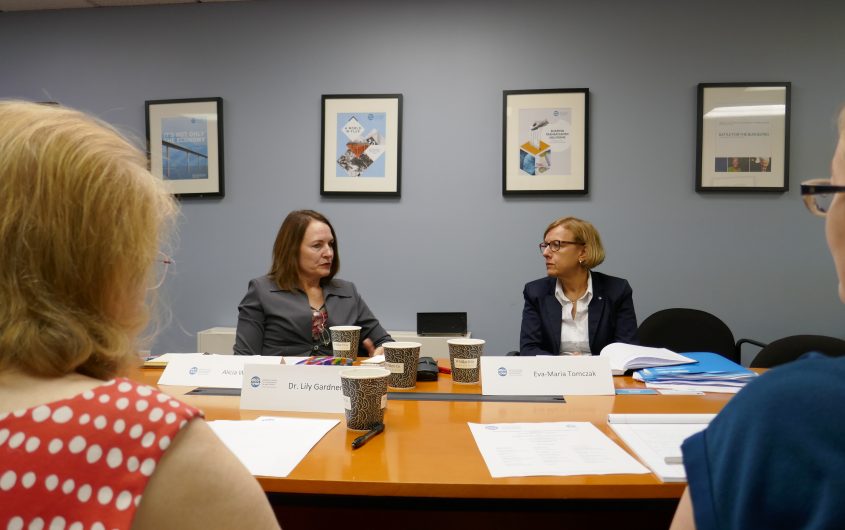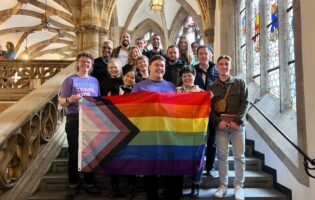
Workforce Integration of Immigrants in the United States and Germany

Elizabeth Hotary
Communications Officer
Elizabeth Hotary is the Communications Officer at AICGS. She creates and implements communications strategies, coordinates publishing activities, and manages media relations. She contributes to AICGS research on workforce education and immigration and integration and has co-led AICGS study tours across the United States and Germany. Before joining AICGS, she taught English at a secondary school in Herne, Germany, as part of the Fulbright Program. During her time as a Fulbrighter, she also volunteered with the U.S. Consulate Düsseldorf’s MeetUS program, where she traveled to schools across North Rhine Westphalia to speak with secondary school students about the United States. She has previous experience at the University of Denver's Josef Korbel School’s Office of the Dean and WorldDenver, a nonprofit global affairs organization.
Ms. Hotary received her MA from the Josef Korbel School of International Studies at the University of Denver, where she was a Marc Nathanson Fellow. She graduated magna cum laude from the University of Arkansas with degrees in International Relations, European Studies, and German. She is an alumna of the Aspen Seminar for Young European Leaders "Next-Gen Europe: Leading for Values."
__
Local and Religious Perspectives
As immigrants and refugees arrive in both the U.S. and Germany, they must quickly navigate new bureaucracies, languages, and workforces. Religious institutions and organizations are key to providing services to new arrivals at the local level. They can help deliver services and other bureaucratic needs as well as providing individualized, person-to-person support institutionally and by partnering with local congregations. On September 28, AGI hosted a seminar to discuss comparative strategies of integration. Eva-Maria Tomczak presented federal, regional, and local initiatives of the Catholic Church in Germany and Alicia Wrenn presented initiatives of the Lutheran Immigration and Refugee Service (LIRS).
View PowerPoint on Workforce Integration in Germany
View PowerPoint on Workforce Integration in the U.S.
German Integration
In 2015, 890,000 people applied for asylum in Germany, five times as many as the year before. Numbers have decreased since due to European policies; from January to August 2018, 127,525 people have applied for asylum. German organizations and authorities must overcome language barriers, paperwork inconsistencies, the German bureaucratic demands of education standards, cultural expectations of Germans and newcomers, and everyday challenges to provide support to newly arrived refugees and migrants.
Who Helps?
- Government agencies help at the federal (Office for Migration and Refugees), regional (Pakt für Integration), and local (district offices) level.
- The Catholic Church also offers support at the federal, state, and local level.
- At the federal level, they offer pastoral care, welfare services, and programs in Germany and abroad regarding migration development.
- Caritas is the Catholic Church Welfare Service. At the national level they have over 900 individual organization units, over 600,000 employees, and 500,000 volunteers. There is an equivalent protestant body.
- Catholic Germany has 27 dioceses, and Caritas services are organized by the diocesan Caritas associations.
- The church works together with other organizations, secular and religious, to collaborate on issues regarding refugee work. These organizations offer employment assistance, counseling, youth services, and legal assistance to provide holistic support for migrants and refugees.
- At the federal level, Caritas supports counseling services for adult and youth migrants. They also have programs to support Caritas volunteers which include training and coordination to provide better refugee services and partnerships. This includes a program for Germans to become “Godparents” for refugee families, strengthening person-to-person ties.
- At a regional level, the church provides pastoral care, welfare services, education, and a variety of programs focused on the individual.
- Pastoral care includes a contact point between pastors and Christians looking for parish communities and daily life support.
- Welfare services are provided through Caritas Diocesan Association.
- Education programs are for refugees but also Germans, providing a forum for Germans to learn about the culture of newcomers and alleviate fears that lead to extreme anti-immigrant views.
- Programs partner with government organization to help youth navigate the educational system and get apprenticeships.
- Local initiatives are focused on individual needs.
- Refugees who have gone through the system support young people through local projects and help them navigate German bureaucracy.
- Local employers in need of a workforce and refugees in need of a job come together at job speed-dating events.
There are numerous initiatives in Germany that are designed to provide support to refugees and immigrants and include efforts regarding societal and workforce integration. Joint initiatives with neighboring countries France and Switzerland also exist. Social media contributes greatly to disseminating resources and forging connections among refugees.
American Integration
LIRS is one of nine agencies resettling refugees in the United States. Of the nine agencies, eight are religiously affiliated. The National Lutheran Council began resettling refugees in 1939; they evolved to LIRS in 1967. The number of refugees resettled by LIRS each year is dependent on presidential determination, and refugee arrivals do not always meet the ceiling made by presidential determination. 2018 is expected to hit a historic low—even post-9/11 was higher. LIRS works through 38 implementing partners in 23 states. Most partners are housed in Lutheran social service agencies.
Lutheran aspect of refugee resettlement
- Lutherans believe in the concept of “the long welcome,” working to integrate refugees into the United States after the 90 day period given by the State Department.
- Refugees have 90 days to receive monetary support from the State Department, get a social security number, a job, etc.
- Local churches provide important context for implementation of State Department directives.
- Before 1980 churches did most of the programming, but after 1980 LIRS took over and programming was regulated by the State Department.
- Over the last couple of years, there has been a huge outpouring from churches wanting to be involved with refugee resettlement, so the church developed a co-sponsoring program.
Circle of Welcome Cosponsor program
- Participation requires a year-long volunteer commitment and a financial contribution.
- The current program has six partner sites, 36 teams from 11 congregations matched to refugee cases.
- The program is a way to engage the church with LIRS programs.
- Congregations partner with new refugees for English language practice, cultural mentorship and exchange, community guidance, college prep, and career networking.
- It is an important way to support personal needs outside of bureaucratic requirements.
- LIRS provides seed money, technical assistance and training, and support for volunteers.
- Churches not in a partner site can be part of the program as distant partners in which they provide monetary support and advocate for refugee resettlement in communities where programs do not yet exist.
- Churches who take part in the program are stakeholders who become speakers, informers, and advocates.
Overall, the goal of the diverse programs is to increase successful outcomes for refugees and their families. Challenges exist on both the support and refugee side and there is no standardized way to measure integration in the U.S. Outcomes are typically program, not client-specific.
Discussion
- All refugees and asylum seekers in Germany and the U.S. have papers/legal documentation. LIRS has other programs who work with undocumented individuals.
- LIRS has career planning and counseling to inform refugees about the U.S. employment system. Often, refugees find a job right away in order to comply with State Department regulation, but LIRS supports long-term career planning so people know their options as they integrate into the United States.
Both organizations try to support both bureaucratic needs as well as personal needs of the individual, and one of the best ways to do so is connecting them with other individuals.









